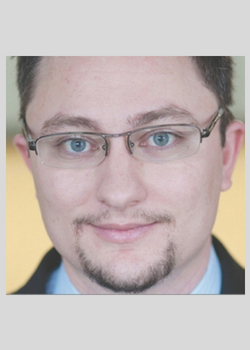Has it just vanished in smoke: l'esprit du temps? Several thousand years is a vast patch of history, perhaps in the interim, the novelty of a desert Sanctuary has simply seeped away. All its glory and wondrous color faded and stonewashed like an old beach-towel; its imminence lost on us, far more, in fact, than last week's paper left to yellow in the sun. The Sanctuary's time is not our time or our great-grandparents' time. What chance is there that this Sanctuary can stir our hearts as in days of old?
Admittedly, the descriptions are pleasant enough: A portable gilded ark, crowned with cherubs; embroidered winged-sphinxes sewn into expensive curtains made of fine goat hair, perhaps a variety of Mohair or Cashmere, if we think on it. There are silver loops and clasps connecting this and that; an indoor altar and an outdoor altar; a golden candelabrum, and a great deal more.
But no amount of familiarity with the text seems to alter its foreignness. Imagine having to describe a spirited summer in Paris to someone who has never sat in a Café, or seen the inside of an art gallery, or fallen in love. The Louvre is nothing but a U-shaped palace, the Seine just another river; the scope of l'Arc de triomphe never quite translates if one has never spent ten minutes walking around its wide roundabout. Thankfully, the Torah has a way of easing us into the unfamiliar, even when most paths are shut; there is always another point of entrée.
One of the stranger aspects of the Tabernacle is that transmission of its many details is twice juxtaposed with the law of Shabbat. The initial five and-a-half chapters of Tabernacle blueprints culminate in a reminder to 'guard the Sabbath by refraining from prohibited labor - malacha' (Ex. 25.1 - 31.12-17).
Additionally, when the time comes for actual construction, this later section is introduced with yet another mention of Shabbat: 'For six days shall labor be done, but on the seventh day, there shall be for you holiness, a Sabbath of solemn-rest to the Lord [...] You shall kindle no fire throughout all your habitations on the Sabbath Day' (Ex. 35.2-3).
Our Sages find in the strange proximity of these two subjects a stern warning. 'Despite God's command, construction of the Sanctuary was to cease on the Sabbath.' (Rashi, Sforno) Why, some might ask? Is it not all for God? Later in the Torah Portion, we read that the people have made and donated far more material than was necessary for the building of the Sanctuary. So much so that Moses announces: "'Let neither man nor woman make any more work for the sanctuary.' So the people were restrained from giving" (Ex. 36.6). The exuberance of ancient Israel captures humanity's boundless desire to fashion and make. Creation never quite ends on its own, for things can always be made better...grander...different. Then there is the danger that mindful work evolves into mindless productivity. The philosopher Raoul Vaneigem had this to say, "In an industrial society which confuses work and productivity, the necessity of producing has always been an enemy of the desire to create."
Without Moses cry of 'enough,' what compels to pause from projects great and small alike, if not mandatory Sabbath? Strikingly, what is odd about the Sanctuary and the Sabbath is that they are both holy, yet they do not quite mix. Like two great magnets of the same polarity, holiness of rest and holiness of work, though infused with a sacred charge, nevertheless push one another away. The Sabbath prevents the Sanctuary from being refurbished each month, from being ever remodeled and expanded each year.
The old awe of the Sanctuary may not be felt as it ought to be, especially when the average home is a great deal bigger than the Tent of Meeting. But we know the satisfaction of successful human labor, whether it's a simple well-made soup or seeing a skyscraper rise up and kiss the clouds. We can also appreciate the dangers of overwork, one-mindedness, Napoleonic obsession, where no palace is large enough, no monument tall enough.
It is something of interest that of the many labors needed to create the Tabernacle, only the making of fire is explicitly mentioned in the beginning of Parashat Vayekhel: 'You shall kindle no fire...on the Sabbath Day.' Rabbi Ovadiah Sforno suggests that fire is so basic to human industry, that a great many other labors could not be performed without it. But I prefer to end with a line by the poet Theodore Roethke:
What lives again? Only a man of straw -
Yet straw can feed a fire to melt down stone.
Fire can forge temples and cities or usher in the Sabbath with its light, but if man's industry is left to burn unchecked, it can turn a Tabernacle into a spectacle, the Sabbath into just another day of work, and even melt the stone Tablets that reside in the Ark of the Covenant.
Shabbat Shalom

